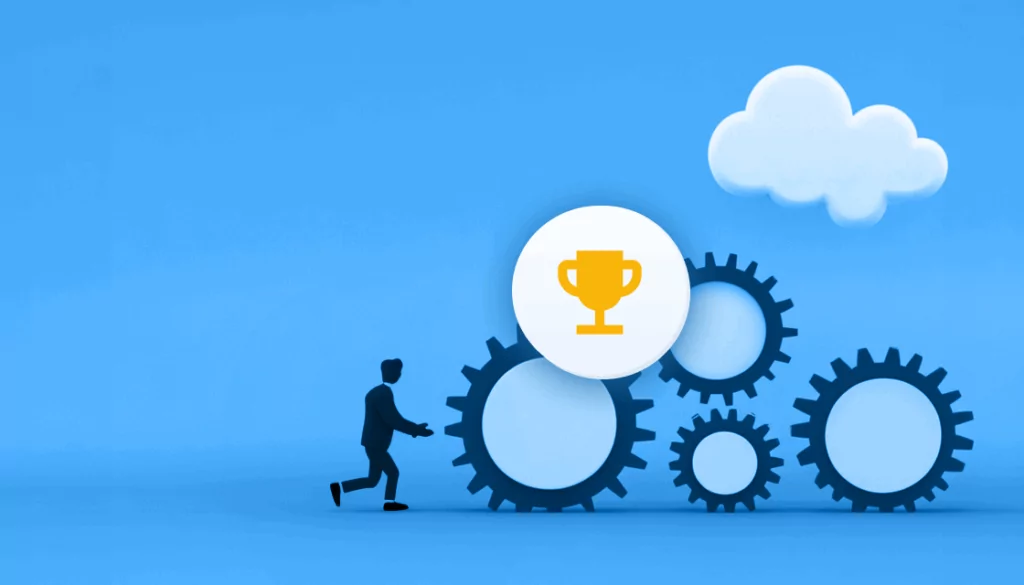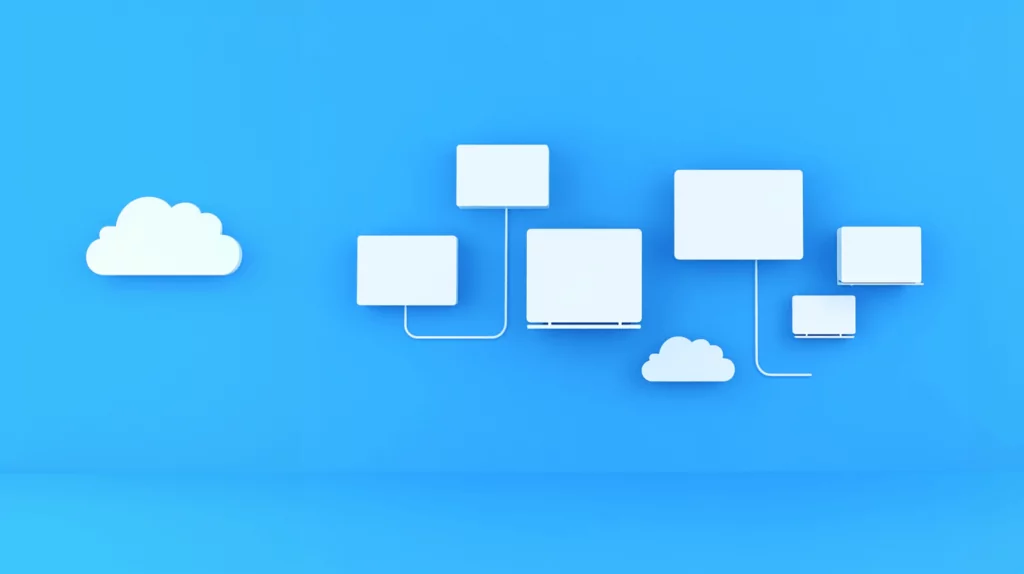What Is Enterprise Architecture?
Enterprise architecture maps out the structure and operation of an organization to help decision makers navigate its complexity.
It is effectively a digital blueprint of an organization, providing a conceptual view of how the different parts of a business fit together. It helps strategy leaders create roadmaps for both long-term and short-term change and assess the potential impact of those changes.
According to Marcus Blosch, VP Analyst at Gartner, at least 40% of organizations will be using enterprise architecture to help drive business innovation through emerging technologies.
Enterprise architecture emerged during the 1980s as IT started to become integral to corporate business strategy. At first, it was just the domain of IT. However, its scope has since widened to encompass the entire operation of the enterprise.
Table of Contents
Toggle- What Is Enterprise Architecture?
- What Are Enterprise Architecture Tools?
- Benefits of Enterprise Architecture Tools
- Key Features of Enterprise Architecture Tools
- Tips from the Expert
- Types of Enterprise Architecture Tools
- Top Enterprise Architecture Tools
- How to Choose Enterprise Architecture Tools
- Enterprise Architecture Trends for 2024 and Beyond
- Conclusion
This is part of a series of articles about IT Asset Management
What Are Enterprise Architecture Tools?
Enterprise architecture (EA) tools are software applications that enable modeling, analyzing, and planning the organizational structure and technical architecture of an enterprise. These tools help organizations understand and visualize their structure, processes, information systems, and technologies in a coherent manner. They can be used to plan:
- Data
- Processes
- Relationships
- Infrastructure
- Technology
- Products
- Compliance and security
EA tools enable the creation of architectural diagrams, documentation, and models that represent the current and future state of an organization. They help enterprise architects manage and communicate complex information, ensuring alignment between business and IT strategies.
Benefits of Enterprise Architecture Tools
The main benefits of enterprise architecture tools are:
- Informed decision making—by providing the intelligence needed to plan strategic change in the most cost-effective and sustainable way, and ultimately deliver successful business outcomes
- Reduced risk to information assets—by serving as an aid to data governance and compliance
- Improved agility—by helping enterprises respond more quickly to events and the changing business landscape
- Progress monitoring—giving the enterprise an up-to-date picture of its digital transformation journey so it can evaluate the impact of change
- Better collaboration between different departments—helping to improve team alignment and standardization of environments across the organization
- Mergers and acquisitions—provides useful insights for managing these processes
Key Features of Enterprise Architecture Tools
Key features of enterprise architecture tools include:
- Modeling capabilities: Create detailed representations of the enterprise architecture. This includes support for modeling languages and notations such as ArchiMate, BPMN, and UML.
- Repository management: Offer a centralized repository to store and manage architectural artifacts. This repository serves as a single source of truth for all architectural information, ensuring consistency and accessibility across the organization.
- Visualization and diagramming: Allow architects to create comprehensive and interactive diagrams. These visual representations help stakeholders understand complex architectures.
- Framework support: Many EA tools come with built-in support for popular enterprise architecture frameworks like TOGAF, Zachman, and FEAF. This support includes predefined templates, guidelines, and best practices.
- Impact analysis: Enable architects to assess the potential effects of changes within the enterprise architecture. This helps in understanding dependencies and mitigating risks associated with proposed modifications.
- Collaboration and communication: Collaboration tools integrated within EA solutions promote teamwork by allowing multiple users to work on architectural models simultaneously. These features often include version control, commenting, and real-time updates.
- Reporting and analytics: Generate insights from architectural data. Customizable reports and dashboards help monitor progress, track metrics, and make data-driven decisions.
- Integration with other systems: Enable connections with other enterprise systems such as ERP, CRM, and CMDBs. This ensures that the architectural models are enriched with real-time data from external sources.
- Compliance and governance: Help maintain compliance with industry standards and regulatory requirements. EA tools offer features for documenting policies, conducting audits, and managing risks related to the enterprise architecture.

Lanir specializes in founding new tech companies for Enterprise Software: Assemble and nurture a great team, Early stage funding to growth late stage, One design partner to hundreds of enterprise customers, MVP to Enterprise grade product, Low level kernel engineering to AI/ML and BigData, One advisory board to a long list of shareholders and board members of the worlds largest VCs
Tips from the Expert
In my experience, here are tips that can help you better leverage enterprise architecture tools and strategies:
-
Involve key stakeholders early
Engage both business and IT stakeholders to ensure EA aligns with strategic goals and minimizes resistance to change.
-
Use scenario planning for changes
Model “what-if” scenarios to understand the impact of potential changes before implementing them.
-
Integrate with Agile practices
Combine EA with Agile to allow for continuous updates and faster adaptation to evolving business needs.
-
Leverage AI for forecasting
Use AI and ML in EA tools to predict trends and identify risks, enabling proactive decision-making.
-
Centralize your EA repository
Maintain a single repository for all EA data to improve collaboration, consistency, and knowledge sharing.
Types of Enterprise Architecture Tools
1. Spreadsheet Software
Spreadsheet software, in particular Microsoft Excel, has long been a common method of recording enterprise architecture information.
It is highly robust, simple, and convenient.
However, as a general-purpose office tool, it isn’t cut out for mapping out complex enterprise architectures and therefore plays a limited role in large-scale business settings.
2. Diagramming and Flow Chart Applications
General-purpose diagramming tools, such as Microsoft Visio and Lucidchart, serve as an aid to data visualization and provide templates for creating diagrams, mapping process flows and modeling organizational structures.
Visio is a more advanced desktop-based product, whereas Lucidchart is browser based and easier to use.
Other tools include Mermaid—a text-based solution, designed for use by developers, which generates visual representations from code that’s similar to Markdown.
3. Knowledge Management Systems
Knowledge management systems, such as Microsoft SharePoint and Atlassian Confluence, provide shared access to documents, reports, archives, and a wealth of other content, making it an invaluable source of enterprise architecture information.
4. Collaboration Tools
An enterprise architecture undertaking cannot succeed without collaboration between different stakeholders across an organization—each with different skill sets and viewpoints. This is important to bridging the gap between IT and wider business objectives, and helping enterprise architects see the bigger picture.
Collaboration tools include Slack and Microsoft Teams, although many other business applications also include collaboration capabilities.
5. Application Dependency Mapping (ADM)
Application dependency mapping is a class of IT mapping, which is closely related to CMDB. However, there are telling differences.
A CMDB is fundamentally a central repository of IT assets with only limited mapping capabilities. ADM offerings, on the other hand, are dedicated application dependency mapping solutions that play a distinct role in enterprise architecture.
ADM tools work in real-time and therefore give a more dynamic picture of how the different components of an application work together, while also enhancing IT visibility. They provide a visual representation of application ecosystems, making it much easier to understand the IT inventory from an enterprise architecture perspective. Additionally, they monitor the health of application components, helping users recognize weak spots and identify areas that need improvement.
Faddom: Supporting Enterprise Architecture with Application Dependency Mapping
Effective IT asset discovery is a must for enterprise architects. For a detailed and granular view of all your assets and dependencies, an agentless, cloud-based IT infrastructure and application mapping software is essential. Faddom helps organizations worldwide to understand their enterprise architecture by mapping their entire hybrid IT environments—both in the cloud and on-premise.
- Faddom is agentless and doesn’t require credentials
- It is cheap, starting at $10K/year
- Map the entire environment in real-time, updating 24/7
- Quick: One person can map the entire organization in an hour
Learn more about Faddom or start a free trial to the right
6. Enterprise Resource Planning (ERP) Software
ERP is the glue that binds an organization’s different processes and computer systems together. It therefore has a strong reciprocal relationship with enterprise architecture.
This is not only because information harvested from ERP software helps map out enterprise architecture, but also because insights gained from enterprise architecture can help shape the design of an ERP implementation.
Leading ERP platforms include SAP S/4HANA, Oracle Fusion Cloud, and Microsoft Dynamics 365.
7. Customer Relationship Management (CRM) Systems
CRM systems, such as Salesforce, inform enterprise architecture by providing visibility into the customer acquisition process, an understanding of product issues and customer pain points, and other knowledge, such as sales forecasts and future revenue opportunities.
However, CRM platforms process and store a lot of personal information. So it’s important to give due regard to data privacy and regulatory compliance when using data collected from such systems.
8. Business Intelligence (BI) Software
BI technology does a lot of the legwork for the enterprise architect by collecting raw data from a range of sources and transforming it into meaningful insights that can drive better decision making.
Many BI tools work on a self-service basis, which allows non-technical users to run queries and create data visualizations, dashboards, and reports for themselves.
Popular self-service BI tools include Tableau, Looker, and Qlik Sense.
9. Data Analytics Software
Whereas BI tools can help provide an historical view of the enterprise architecture posture, analytics can help predict how it will evolve in the future and what actions are likely to achieve optimal future outcomes. It is therefore particularly useful for performing impact analysis of transformational processes.
Most of the leading BI offerings also come with data analytics capabilities. But those that specialize in predictive analytics include SAS Advanced Analytics and KNIME Analytics Platform.
10. Data Governance Tools
Data governance tools help enterprises manage the availability, usability, integrity and security of their data. As they help improve the quality of data, they ensure better results from BI and data analytics, and a more accurate picture of enterprise architecture.
11. Configuration Management Database (CMDB)
A CMDB is designed to serve as a single source of truth about a company’s IT assets and supports enterprise architecture by providing comprehensive details about the hardware and software used by an organization and the relationships between them.
It usually comes with a number of built-in capabilities, such as asset discovery, predictive impact analysis of asset changes, and automatic database updates whenever an IT asset changes.
12. Dedicated Enterprise Architecture Tools
Dedicated enterprise architecture tools are specifically designed to help overcome the complexity of capturing, collating and analyzing information from a huge range of data sources across a large-scale organization.
They gather information and associated metadata from IT deployments, both on-premises and in the cloud, and utilize existing content provided by other technologies in the enterprise architecture toolkit.
They connect to different resources via API. However, to simply the setup process, most also offer a number of native integrations. Furthermore, they allow users to enter data manually and are typically designed for use by stakeholders in any department.
Top Enterprise Architecture Tools
1. Ardoq
Ardoq uses graph technology to provide data structure and insights. This technology allows for the visualization of complex relationships and dependencies within the enterprise architecture. It enables more informed and strategic decision-making by offering a clear view of the organization.
Key features:
- Configurable metamodels: Ardoq offers highly configurable metamodels that can be tailored to meet the evolving needs of any organization. This flexibility ensures that the tool can adapt to various business requirements and scenarios, providing relevant and up-to-date architectural models as the organization grows and changes.
- Automated workflows: The tool includes automated workflows for creating surveys, reports, and dashboards, significantly reducing manual effort. These automated processes ensure that all architectural data is current and accurate, providing real-time updates and insights to support continuous improvement and strategic planning.
- Dynamic models and presentations: Ardoq generates dynamic models, presentations, and diagrams that are automatically updated with the latest data. These visual tools help enterprise architects communicate complex architectures clearly and effectively to stakeholders, facilitating better understanding and engagement across the organization.
- Real-time dashboards and reports: Ardoq’s real-time dashboards and reports deliver vital metrics and actionable insights through customizable, self-service interfaces. These tools enable stakeholders to monitor progress, track key performance indicators, and make data-driven decisions.
Source: Ardoq
LeanIX Enterprise Architecture
LeanIX Enterprise Architecture is designed to help organizations streamline their IT landscape management and drive digital transformation with a clear understanding of their IT reality. It supports the entire transformation journey from discovery to implementation and operation.
Key features:
- Accelerate execution: LeanIX enables a continuous and reliable understanding of your IT landscape, facilitating effective technology transformation planning. By connecting enterprise architecture initiatives to critical business capabilities, it helps prioritize tasks and maintain alignment with transformation goals, ensuring smooth execution.
- Optimize IT spend: LeanIX connects technology expenditures to business impact, aiding in the assessment of IT investments. It identifies redundancies, freeing up budget for strategic investments. With insight into dependencies and project complexities, it streamlines budget forecasting, making financial planning more efficient.
- Reduce risk: LeanIX captures the complexity of your IT landscape through an intuitive meta model. By mapping applications to business capabilities, it simplifies planning and enhances risk assessment. Providing universal access to enterprise architecture data ensures data quality and supports informed decision-making across the organization.
- Dynamic models and presentations: LeanIX generates dynamic models and presentations to visualize both current and future states of your IT architecture. This functionality allows stakeholders to understand the impact of changes, plan transformations effectively, and communicate architectural plans clearly, fostering better decision-making and alignment.
- Real-time dashboards and reports: LeanIX offers real-time dashboards and reports that deliver critical metrics and actionable insights through customizable, self-service interfaces. These tools enable stakeholders to monitor progress, track key performance indicators, and make informed decisions, ensuring the enterprise architecture remains aligned with strategic business objectives.
Source: LeanIX
Avolution ABACUS
Avolution ABACUS is an enterprise architecture tool designed for end-to-end modeling, roadmapping, and collaboration across all major architecture domains. It covers business, data, application, security, technology, and solution architecture.
Key features:
- Modeling and analysis: Offers modeling capabilities with intuitive drag-and-drop and automated diagramming tools. Users can design enterprise architectures and use algorithms to automate complex calculations.
- Collaboration: Supports browser-editable data and diagrams, allowing real-time updates and sharing across the enterprise.
- Secure, cloud-based technology: Operates directly and securely in the browser, providing a safe solution for remote and global teams.
- Dynamic modeling and roadmapping: Users can easily build and edit architecture diagrams and process models. Offers features for setting clear timelines, managing technology lifecycles, and mapping current and future state scenarios using industry-standard frameworks like TOGAF and BizBok.
- Automated architecture calculations: Automates critical architecture calculations, such as cost roll-ups, business fit, technical fit, and security scores.
Source: Avolution
Bizzdesign Horizzon
Bizzdesign Horizzon integrates IT insights to support holistic business strategy execution and change management. It offers features for modeling, collaboration, decision-making, and change impact analysis.
Key features:
- Native ArchiMate 3 support: Ensures consistent and standardized modeling across the enterprise.
- Collaboration across departments: Provides a central repository accessible to all team members, eliminating the need to search for architecture artifacts and ensuring everyone has access to the latest information.
- Customizable views and dashboards: Supports decision-making with a variety of view types and visualization options. Users can create tailored dashboards using stakeholder-focused view templates and custom iconology.
- Impact of change management: Helps identify the impact of changes on business and technology landscapes.
- Two-click modeling: Simplifies the modeling process as systems, software, and infrastructure evolve. Helps enterprise architects address gaps across complex processes and identify shared investment opportunities.
Source: Bizzdesign
How to Choose Enterprise Architecture Tools
Choosing the right enterprise architecture tools can impact an organization’s ability to manage and optimize its architecture. Here are some key considerations to keep in mind:
- Scalability and flexibility: Ensure the tool can scale with the organization’s growth and adapt to changing needs. It should handle increasing data volumes and support new functionalities as the enterprise evolves.
- Integration capabilities: Look for tools that offer seamless integration with existing systems and technologies, such as ERP, CRM, and CMDBs. API support and pre-built connectors can simplify the integration process.
- User-friendliness: The tool should have an intuitive interface that is easy to use for both technical and non-technical stakeholders. Features like drag-and-drop modeling and visual dashboards can enhance user experience and adoption.
- Customization and extensibility: Ensure users can customize and extend the tool to meet business requirements. This includes customizable templates, frameworks, and the ability to create custom reports and dashboards.
- Support for industry standards: Ensure the tool supports widely-used EA frameworks such as TOGAF, Zachman, and FEAF.
- Collaboration features: Effective EA requires collaboration across various departments. Look for tools that facilitate teamwork through features like version control, real-time editing, and commenting.
- Security and compliance: The tool should offer strong security features to protect sensitive architectural data. Ensure it complies with relevant regulations and standards, such as GDPR, HIPAA, or ISO/IEC 27001.
- Performance and reliability: Assess the tool’s performance in handling complex architectural models and large datasets. It should have reliable uptime and fast processing speeds to maintain productivity.
Enterprise Architecture Trends for 2024 and Beyond
Enterprise architecture is a highly sophisticated technology that plays an increasingly important role in today’s complex IT landscape. And, although it has been in use for decades, it is still evolving all the time.
First, the underlying technology is likely to change.
For example, more tools are likely to make use of graph databases, which are better equipped to map relationships within the complex network of interdependencies in enterprise architecture.
They will also leverage more artificial intelligence (AI) and machine learning (ML) to facilitate modeling and predict the impact of change.
Automation may also play a more prominent role, helping to reduce the amount of manual work involved in gathering and analyzing information, and improve agility.
And, finally, as organizations face an ever increasing cybersecurity risk, enterprise architecture tools are likely to add more capabilities to help counter threats, adopt a security-by-design approach and mitigate the impact in the event of an attack.
Conclusion
Enterprise architecture tools play a crucial role in helping organizations navigate the complexities of their IT environments. By providing detailed modeling, analysis, and visualization capabilities, these tools facilitate informed decision-making, enhance collaboration, and improve alignment between IT and business strategies. As organizations continue to evolve, leveraging these tools can drive efficiency, agility, and better management of digital transformation initiatives.
Learn more about Faddom or start a free trial by filling out the form on the sidebar!









